Last Sunday I had the honor, along with 3 of my work colleagues, of attending a Japanese Tea Ceremony at the Kaji Aso studio in Boston. Excitement was mounting all week as we eagerly looked forward to our visit. The studio is located right off of Huntington Ave. so it is very easy to find.
Jane, one of the tea apprentices, greeted us at the door as we arrived. She was beautifully dressed in a silk kimono and obi. We were graciously shown into the front room gallery of the brownstone, where the students display and sell their work. Rows of shelving on both sides of the room are filled with beautiful tea bowls, plates and ceramic vessels, created in their studio. After we looked around a little, we were led down a flight of stairs through the ceramics studio and out into the backyard. As we carefully stepped along the worn stone path, I felt my body and spirit relax and slip into that moment in time. I was already getting into “tea mind”.
We entered the vestibule of the “House of Flower Wind” tea house by way of its beautiful garden, complete with koi pond and bamboo water fountains. We were instructed to remove our shoes before we entered the teahouse. A beautiful calligraphy scroll on the wall translates to “One moment, one life” or “One moment, full of friendship”. This principal of tea ceremony expresses the relationship of tea & Zen.
One at a time, we entered the teahouse on our knees, bowed to the teamaster and sat down on the soft mat. We quietly watched as Kate made the tea – dip the bamboo ladle into the water kettle, pour, rinse and clean the tea bowl, spoon the powdered matcha with the bamboo scoop into the bowl, dip and pour the water, whisk the tea into a froth. Her movements were like a graceful dance, so mesmerizing and calming to watch. This first tea was prepared lightly with small sweets to enjoy before drinking the tea. The sweet is a nice balance to the pungency of the matcha. Before the stronger second tea, we had a pastry called “ohagi”, sweetened red beans over sweet rice sprinkled with soy powder. We also had a sweet rice rolled in ground black sesame. These delectable treats were served in 220 year old black lacquer covered bowls. Each tea was served in a tea bowl over 1000 years old. As each one of us in turn quietly drank from each bowl, we felt the ancient venerable energy infusing our tea experience. The tea tasted fresh, clean and delightfully pungent.
Kate, Jane and Jennifer were delightful hosts, each taking a turn to make and serve the tea. We enjoyed chatting with them, during and after tea, learning about the tradition and history of the tea ceremony and about Mr. Aso and the studio he created. We are truly grateful for their kindness and hospitality. They created an amazing experience for us, one that we will never forget!
“I thought I saw you but then the moon hid behind the clouds and I lost you.” -Murasaki Shikibu




Thanks for sharing such a beautiful experience. I really love your tea commentaries.
Thanks Libby! I’m glad you’re enjoying my tea writing.
-Karen
This made me smile 🙂
Karen,
What a wonderful experience. I could picture the tea being prepared and poured. Tea ceremonies are like a dance in honor of the tea. It is a beautiful process.
-Amy
I’m so glad it did, Amanda. Looking forward to our next visit!
Hi Amy, Thanks, I’m glad you were able to picture this amazing experience. I will always cherish the memory of this special “one moment, full of friendship “.
-Karen
[…] Ok, time for my cup of tea. This morning I’m sipping a Japanese Sencha called Supersencha Kamakura. The dry leaf looks like grass clippings, flat, smooth and very green. Green tea has a long history in Japan, having been introduced in the 9th century by a Buddhist monk returning from his travels in China. You can read more about it here. The most well known type of Japanese green tea is Matcha, the powdered green tea used for the Tea Ceremony, Chanoyu (translation: hot water for tea). I had the honor of attending a tea ceremony last fall in Boston and I wrote about it here. […]
[…] forgot I had. I purchased it last year at the Kaji Aso studio in Boston when I attended the Japanese Tea ceremony. The clay is dark brown with white speckles and the glaze looks like it has been applied with a […]
[…] Over time, tea became elevated to a fine art in Japan, culminating with the development of the Japanese tea ceremony known as Chanoyu. I had the privilege of attending a tea ceremony 3 years ago and wrote about it here. […]